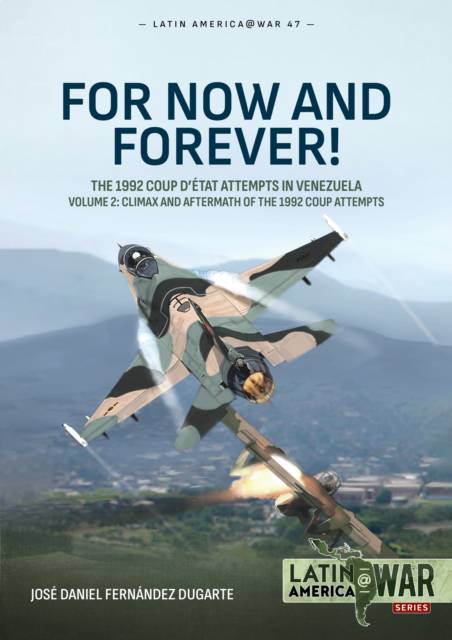
- Retrait en 2 heures
- Assortiment impressionnant
- Paiement sécurisé
- Toujours un magasin près de chez vous
- Retrait gratuit dans votre magasin Club
- 7.000.0000 titres dans notre catalogue
- Payer en toute sécurité
- Toujours un magasin près de chez vous
For Now and Forever!
The 1992 Coup d'Etat Attempts in Venezuela Volume 2. Climax and Aftermath of the 1992 Coup Attempts
José Daniel Fernández Dugarte
27,95 €
+ 55 points
Format
Description
Rich in oil, Venezuela should, in theory, have been one of the wealthiest nations in Latin America -- if not the world. Yet by the 1980s, the collapse in oil prices plunged the country into economic crisis. Widespread corruption, falling living standards, and growing inequality ignited public unrest, culminating in the Caracazo riots of 1989. The violent repression that followed, with hundreds killed by security forces, shocked the nation and sowed the seeds of rebellion within the armed forces. Among the disillusioned was a group of junior officers inspired by reform and led by a charismatic figure -- Lieutenant Colonel Hugo Chávez.
In 1992, Venezuela was convulsed by not one but two military coups, both aimed at unseating President Carlos Andrés Pérez. The first, in February, was a coordinated but ultimately unsuccessful uprising led by Chávez's MBR-200 movement. It saw intense urban fighting, street battles between army units, and aircraft attacking targets in the capital. Volume 1 of For Now and Forever charted the build-up to that moment: the historical roots of military involvement in Venezuelan politics, the evolution of the armed forces, and the initial outbreak of the February coup attempt.
This second volume picks up the story in the aftermath of that failed rebellion. While Chávez was imprisoned and became a national symbol of defiance, the embers of insurrection still glowed. Just nine months later, on 27 November 1992, a second, far more audacious coup attempt erupted--this time involving a much larger segment of the armed forces, including significant elements of the air force. Mirage fighters, OV-10 Broncos, and Alouette helicopters took to the skies, launching air strikes against loyalist bases and government targets. For the first time in modern Latin American history, a full-scale aerial civil war briefly broke out above a major capital city.
For Now and Forever Volume 2 provides a detailed and gripping account of this extraordinary moment in Venezuelan and Latin American history. Drawing on official records, rare photographs, and first-hand testimony, author José Daniel Fernández Dugarte reconstructs the dramatic events of the November coup attempt, its planning, execution, and eventual collapse. The book vividly portrays the chaos that unfolded across military bases and urban centres, and the consequences that followed for both the coup plotters and the Venezuelan state.
Lavishly illustrated throughout with previously unpublished photographs, specially commissioned colour artworks, detailed maps, and appendices profiling the combat aircraft of the Venezuelan Air Force, this volume offers a comprehensive and visually striking portrayal of a failed revolution and its legacy. It is a vital continuation of the story begun in Volume 1 and a crucial reference for students of modern military history, Latin American politics, and revolutionary movements.
In 1992, Venezuela was convulsed by not one but two military coups, both aimed at unseating President Carlos Andrés Pérez. The first, in February, was a coordinated but ultimately unsuccessful uprising led by Chávez's MBR-200 movement. It saw intense urban fighting, street battles between army units, and aircraft attacking targets in the capital. Volume 1 of For Now and Forever charted the build-up to that moment: the historical roots of military involvement in Venezuelan politics, the evolution of the armed forces, and the initial outbreak of the February coup attempt.
This second volume picks up the story in the aftermath of that failed rebellion. While Chávez was imprisoned and became a national symbol of defiance, the embers of insurrection still glowed. Just nine months later, on 27 November 1992, a second, far more audacious coup attempt erupted--this time involving a much larger segment of the armed forces, including significant elements of the air force. Mirage fighters, OV-10 Broncos, and Alouette helicopters took to the skies, launching air strikes against loyalist bases and government targets. For the first time in modern Latin American history, a full-scale aerial civil war briefly broke out above a major capital city.
For Now and Forever Volume 2 provides a detailed and gripping account of this extraordinary moment in Venezuelan and Latin American history. Drawing on official records, rare photographs, and first-hand testimony, author José Daniel Fernández Dugarte reconstructs the dramatic events of the November coup attempt, its planning, execution, and eventual collapse. The book vividly portrays the chaos that unfolded across military bases and urban centres, and the consequences that followed for both the coup plotters and the Venezuelan state.
Lavishly illustrated throughout with previously unpublished photographs, specially commissioned colour artworks, detailed maps, and appendices profiling the combat aircraft of the Venezuelan Air Force, this volume offers a comprehensive and visually striking portrayal of a failed revolution and its legacy. It is a vital continuation of the story begun in Volume 1 and a crucial reference for students of modern military history, Latin American politics, and revolutionary movements.
Spécifications
Parties prenantes
- Auteur(s) :
- Editeur:
Contenu
- Nombre de pages :
- 72
- Langue:
- Anglais
- Collection :
Caractéristiques
- EAN:
- 9781804517185
- Date de parution :
- 31-08-25
- Format:
- Livre broché
- Format numérique:
- Trade paperback (VS)
- Dimensions :
- 206 mm x 296 mm
- Poids :
- 249 g

Seulement chez Librairie Club
+ 55 points sur votre carte client de Librairie Club
Les avis
Nous publions uniquement les avis qui respectent les conditions requises. Consultez nos conditions pour les avis.








